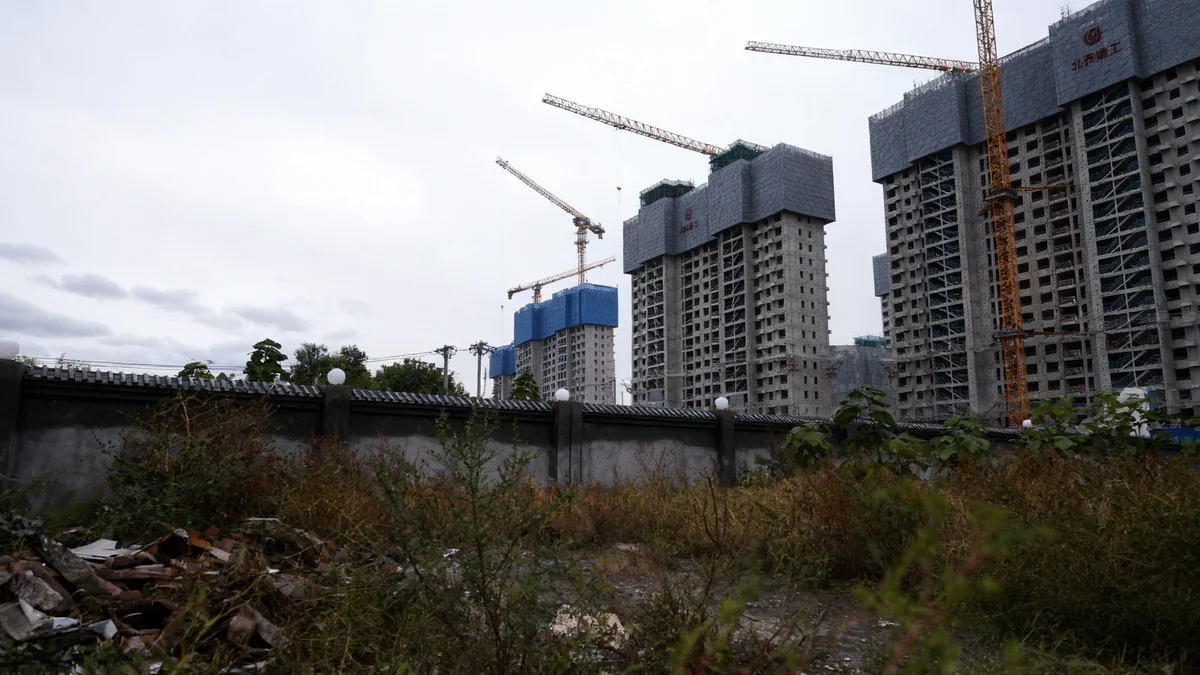New home prices in China experienced their most significant monthly decline in 11 months, with data from September showing a 0.4% drop. This acceleration from the 0.3% decrease seen in August highlights the persistent challenges facing the nation's property sector and its wider economic impact.
The downturn, which began in 2021, continues to weigh heavily on consumer confidence and household spending. According to figures from the National Bureau of Statistics (NBS), the slump is a considerable drag on China's overall economic growth, prompting calls for more decisive government intervention.
Key Takeaways
- New home prices in China fell by 0.4% month-on-month in September, the sharpest decline in 11 months.
- On an annual basis, prices for new homes were down 2.2% compared to the previous year.
- The price decline was widespread, with 63 out of 70 surveyed cities reporting a monthly drop in new home values.
- The ongoing property slump is negatively impacting consumer confidence and contributing to slower national economic growth.
Widespread Price Declines Across the Nation
The latest data from the National Bureau of Statistics paints a clear picture of a housing market under pressure. The decline in new home prices was not isolated, affecting the vast majority of urban centers. In September, 63 of the 70 cities included in the official survey reported a month-on-month decrease in prices.
Year-over-year figures also show a sustained downward trend. While the 2.2% annual drop in September was slightly less severe than the 2.5% fall recorded in August, it demonstrates that the market has not yet found a stable footing.
Understanding City Tiers
In China, cities are often categorized into tiers based on their economic size, population, and political importance. Tier-one cities include major hubs like Beijing, Shanghai, Guangzhou, and Shenzhen. Tier-two cities are large provincial capitals, while tier-three consists of smaller, yet significant, urban areas. These classifications help in analyzing regional economic and real estate trends.
Secondary Market Feels Greater Pressure
The market for existing homes, often called the secondary market, is experiencing even more significant price corrections. According to the data, these declines were most pronounced in smaller cities.
- Tier-one cities: Secondary home prices fell by 3.2% year-on-year.
- Tier-two cities: Prices dropped by a more substantial 5.0% year-on-year.
- Tier-three cities: This segment saw the steepest decline, with prices falling 5.7% year-on-year.
This trend suggests that buyer confidence is particularly low outside of the largest metropolitan centers, where the economic fallout from the property downturn is felt more acutely.
Economic Ripple Effects and Consumer Sentiment
The property sector, once a primary engine of China's economic expansion, has become a significant drag. The prolonged slump, marked by developer debt defaults and unfinished housing projects, has eroded the confidence of potential homebuyers and investors.
This has a direct impact on household wealth and spending habits. Hanna Liu, a China economist at Nomura, explained the connection between property values and consumer behavior.
"If the value of real estate, especially in first-tier cities, continues to shrink, people will feel they have less money to spend and will expect even less in the future," Liu stated.
This sentiment is reflected in broader economic data, which showed that China's headline economic growth slowed in the third quarter. The housing market's weakness is a key factor contributing to this slowdown, alongside global trade challenges.
Peak Season Disappointment
Traditionally, September and October represent a "golden" peak season for property sales in China, as developers launch major campaigns around national holidays. However, the deep-seated consumer pessimism has largely nullified this seasonal boost, with transaction volumes remaining weak.
Policy Responses and Future Outlook
In response to the downturn, Chinese authorities have implemented various measures over the past two years. These include cutting mortgage rates, easing home purchasing restrictions in many cities, and launching campaigns to redevelop older urban areas. However, these policies have so far failed to spark a meaningful recovery.
Analysts believe more substantial support may be on the horizon. Zhang Dawei, chief analyst at Centaline Property Agency, suggests that further measures could be introduced in the fourth quarter to bolster confidence. These might include additional mortgage rate reductions and expanded personal income tax deductions related to housing.
Despite potential new policies, the outlook remains cautious. Zhang predicts that overall property transaction volumes could fall by 10% this year. Many experts warn that it could take a year or more for prices and investment in the sector to stabilize and begin a recovery.
Focus on Long-Term Stability
The property market's future is a central topic as China's leaders convene to map out the country's 15th five-year development plan, which will cover the years 2026 to 2030.
Analysts expect the government's long-term strategy to prioritize stability over rapid growth in the real estate sector. Jeff Zhang, a property equity analyst at Morningstar, commented on the likely policy direction.
"The tone set by the meeting for the property market will still prioritise sector stability, while encouraging local stimulus policies such as home purchase subsidies and tax reductions," he said.
Nomura analysts echoed this, noting in a recent report that the government would need to "more seriously address the fallout from the property market collapse" in its new long-term plan. The challenge for policymakers is to manage the controlled deleveraging of the sector without causing a severe shock to the broader economy and financial system.





